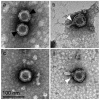A Novel Genus of Actinobacterial Tectiviridae
- PMID: 31817897
- PMCID: PMC6950372
- DOI: 10.3390/v11121134
A Novel Genus of Actinobacterial Tectiviridae
Abstract
Streptomyces phages WheeHeim and Forthebois are two novel members of the Tectiviridae family. These phages were isolated on cultures of the plant pathogen Streptomyces scabiei, known for its worldwide economic impact on potato crops. Transmission electron microscopy showed viral particles with double-layered icosahedral capsids, and frequent instances of protruding nanotubes harboring a collar-like structure. Mass-spectrometry confirmed the presence of lipids in the virion, and serial purification of colonies from turbid plaques and immunity testing revealed that both phages are temperate. Streptomycesphages WheeHeim and Forthebois have linear dsDNA chromosomes (18,266 bp and 18,251 bp long, respectively) with the characteristic two-segment architecture of the Tectiviridae. Both genomes encode homologs of the canonical tectiviral proteins (major capsid protein, packaging ATPase and DNA polymerase), as well as PRD1-type virion-associated transglycosylase and membrane DNA delivery proteins. Comparative genomics and phylogenetic analyses firmly establish that these two phages, together with Rhodococcusphage Toil, form a new genus within the Tectiviridae, which we have tentatively named Deltatectivirus. The identification of a cohesive clade of Actinobacteria-infecting tectiviruses with conserved genome structure but with scant sequence similarity to members of other tectiviral genera confirms that the Tectiviridae are an ancient lineage infecting a broad range of bacterial hosts.
Keywords: Streptomyces; actinobacteria; capsid protein; lipid membrane; pathogen; plant; potato scab; tectivirus.
Conflict of interest statement
The authors declare no conflict of interest. The funders had no role in the design of the study; in the collection, analyses, or interpretation of data; in the writing of the manuscript, or in the decision to publish the results.
Figures





References
Publication types
MeSH terms
Substances
Grants and funding
LinkOut - more resources
Full Text Sources
Molecular Biology Databases

